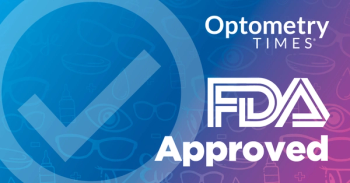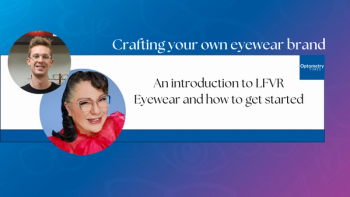
AOA 2025: Ocular toxicities in cancer patients – A Q&A with Dr Joe Shovlin
Joe Shovlin, OD, FAAO, sat down with Optometry Times to detail a presentation he gave at AOA's Optometry's Meeting 2025.
During Optometry's Meeting 2025, Joe Shovlin, OD, FAAO, gave a presentation on ocular toxicities in patients with cancer, highlighting current therapies and their toxicity profiles. He sat down with Optometry Times to highlight key points of his presentation, including the increased toxicity from targeted immunotherapies like chimeric antigen receptor (CAR) T-cell therapy and checkpoint inhibitors, which often require careful management to avoid vision-threatening complications.
Jordana Joy:
Can you give us an overview of your presentation on ocular toxicities in patients with cancer?
Joseph P. Shovlin, OD, FAAO:
So this is a 1-hour lecture that looks at a couple of different issues related to cancer patients. The first is some current therapies, especially as they relate to ophthalmic cancers, current breakthroughs, and then looking at some of these drugs, what they're actually causing as a potential toxicity profile of specific agents. The 2 broad categories would be the molecular-targeted agents, and then the traditional chemo agents. Then we're going to look at some clinical manifestations of drug-induced disease, especially as it relates to the cornea and retina with a few case examples, future treatment options down the road, and then end with a summary of recommendations.
Joy:
So are these toxicities something that is seen in more common cancer treatments, or is this something that you're seeing a spike in because of these new treatments?
Shovlin:
We can certainly see it with conventional chemos, but when that doesn't work, and now we're making a move toward more targeted immunotherapies like CAR T-cell therapy and checkpoint inhibitors and antibody drug conjugates, and then there are an unbelievable number of monoclonal [used today]. So with these medications, they were beginning to see an increase in toxicity because they're being used more often, so the clinician must be aware of specific ramifications so that they can talk to the oncologist. In some cases, we don't stop the therapy, because this is life-saving therapy, and we just have to do the best we can with the ocular complications. There are some exceptions to that. When they're potentially sight-threatening, then we have to have a serious discussion with the oncologist. We don't want to put a lot of pressure on them; at the same time, they're educated also on what the ophthalmic ramifications are for the most part, especially with these biologic cancer therapies right now. Anything that ends in mAb, it's a monoclonal antibody. The other big category is tyrosine kinase inhibitors, and they usually end in -nib. Each and every one of them has potential toxicities, in some cases, not just the eye.
Joy:
These toxicities, how do they normally present? What are some of those red flags of knowing when it is getting severe, where it is getting vision-threatening, or when it's something to monitor?
Shovlin:
Well, a big one right now is the antibody-drug conjugates, the ADCs, and they tend to deposit in the cornea. So they probably come in from the conjunctival side, the conjunctival vessels, and they're deposited in cornea. But the big ones would be in particular, Elahere, which is used for cancers in women, [used in women with resistance to platinum-based treatment for ovarian, fallopian tube, or primary peritoneal cancers], and they are really quite prone to showing deposits in the cornea. They start in the periphery and move toward the center, and they can have some definite impact on the patient's vision. The interesting thing too is it can have a significant refractive effect as well. So the patient may come in and say, "How come I'm using my old glasses, or I can't see with my new prescription?" So things we can do are we need to document these [cases]. Patients at the time of their infusion should have steroid use. We use cold compresses. We use vasoconstrictors. We use artificial tears. And some of them seem to work pretty well, and some of them are just okay. But then from a retina standpoint, there are different biologics that are used, like interferon and monoclonal antibodies, small molecule inhibitors like MEK inhibitors. The traditional chemos are not immune to these things; alkylating agents can cause vasculitis or artery occlusions. There are microtubular derivatives that cause macular edema. You can get retinoic acid derivatives that impair night vision, but those are the traditional chemo agents. Big ones right now are Opdivo, Keytruda. These are checkpoint inhibitors used for melanoma, small cell cancer, lung and renal cell cancers, and even Hodgkin lymphoma. Balversa is a big one, and that's first-in-the-class of kinase inhibitors approved by the FDA for bladder cancer. [They can cause subretinal and intraretinal edema.] We had a lady who presented a couple years ago getting treatment for breast cancer, and she had a bilateral artery occlusion from one of the traditional chemotherapies. So you've really got to put it all together and just make sure you educate not just the primary care physician, but especially the oncologists that are treating these things. Even the immune checkpoint inhibitors can cause cranial nerve disorders. So it's not just the retina and the cornea, but they can end up with double vision because of cranial nerve disorders where they have an isolated cranial nerve or multiple cranial nerve palsies.
Joy:
Going off of that point of working with oncologists and PCPs and everyone involved in that treatment process, what are some of the nuances in comanagement with patients with cancer, and what does successful comanagement look like?
Shovlin:
I would follow the recommendations of the manufacturer. They ask you to see the patient around the infusion time so you can check and then sometimes, if they do show toxicity, the oncologist will either increase the interval between infusions or actually decrease the dosages, because that may help. We had one patient recently on Elahere, they increased the interval between dosages, and we did cold compresses at the time of infusion, and also half-dose therapies. So again, her PET scans are looking pretty good, so we don't want to fool around too much with her therapies, because it seems to be working for her.
Joy:
If you had a few key takeaways that you hope eye care providers are able to take from this presentation, what would those be?
Shovlin:
Review the literature. Be on the guard. Be on the lookout for these ocular toxicities. So frequent ocular examinations are needed for any cancer patient receiving systemic or oral chemotherapeutic agents. Know the drug classifications. I think that's helpful. There's a broad knowledge associated with each [adverse] effect. I would review product labels constantly, because the manufacturers may change recommendations. Strongly encourage retinal OCTs. They're very helpful in detecting subtle edemas. Depending on the severity of the response, a drug holiday, which is in the form of completely stopping the medications or reduced dosing, or increasing the intervals between the dosages, can be very helpful, but that's really something the oncologist has to decide. I do have a couple slides on ocular melanomas, which can be associated with other skin cancers. If that patient has an ocular melanoma and another form of cancer, you need to do a BAP1 mutation, because there's some concern with mesothelioma.
Newsletter
Want more insights like this? Subscribe to Optometry Times and get clinical pearls and practice tips delivered straight to your inbox.


















































.png)


